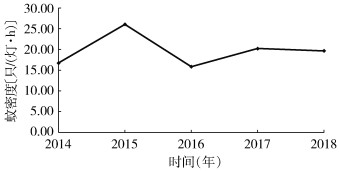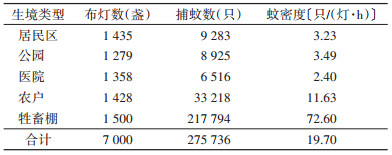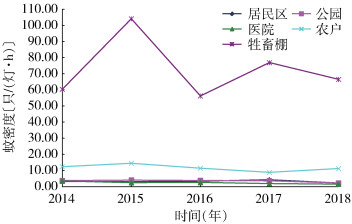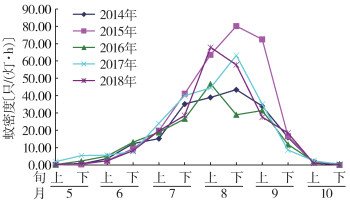扩展功能
文章信息
- 丁俊, 王纯玉, 白玉银, 张稷博
- DING Jun, WANG Chun-yu, BAI Yu-yin, ZHANG Ji-bo
- 辽宁省2014—2018年蚊虫密度与季节消长监测分析
- Surveillance and analysis of mosquito density and seasonal fluctuation in Liaoning province, China, 2014-2018
- 中国媒介生物学及控制杂志, 2021, 32(2): 169-172
- Chin J Vector Biol & Control, 2021, 32(2): 169-172
- 10.11853/j.issn.1003.8280.2021.02.010
-
文章历史
- 收稿日期: 2020-07-08
蚊虫是重要的病媒生物,可传播登革热、流行性乙型脑炎(乙脑)、疟疾等疾病。2018年辽宁省盘锦市等地区乙脑流行,共发生68例病例,病死率高达19.12%[1]。为了解辽宁省蚊虫种群分布、密度及季节消长变化规律,给全省蚊虫防制工作提供科学依据,辽宁省疾病预防控制中心(CDC)按照《全国病媒生物监测方案(试行)》[2]和《中国疾病预防控制中心关于印发全国病媒生物监测实施方案的通知》〔2016年〕文件要求,制定《辽宁省病媒生物监测实施细则》,各市CDC组织开展辖区内的病媒生物监测工作。我们对2014—2018年的蚊虫监测资料进行了整理,现将结果报告如下。
1 材料与方法 1.1 资料来源资料来源于2014—2018年辽宁省14个市的各种病媒生物监测统计报表中的数据。
1.2 材料诱蚊灯,采用光催化捕杀蚊蝇器,由武汉市吉星环保科技有限责任公司提供,波长360~380 nm,灯泡功率8 W。
1.3 方法 1.3.1 监测点的设置全省城市选择居民区、医院和公园3类适合蚊虫栖息活动的场所为监测地点,农村选择农户和牲畜棚2类场所为监测地点,监测点一旦设定不再变动。
1.3.2 监测时间2014—2018年每年监测1个消长周期,即从5月上旬起,至l0月连续2次蚊密度为0时止,每月监测2次,即当月3—5日和18—20日各监测1次,遇风雨天气顺延(风力5级以上),以月为统计单位。
1.3.3 监测方法采用诱蚊灯法进行监测。于日落后20 min开灯,连续捕蚊2 h后关灯,诱蚊灯应悬挂于远离干扰光源、避风、空旷、黑暗之处,距地面高度1.5 m。将捕获蚊虫密闭于捕虫网中,用乙醚熏杀或冷冻的方式处死蚊虫,分类计数。准确填写现场工作记录表,计算蚊密度指数。

|
运用SPSS 18.0、Excel 2010软件对辽宁省2014—2018年不同生境蚊虫监测数据进行统计分析。
2 结果 2.1 蚊种构成 2.1.1 不同年份蚊种构成从2014—2018年辽宁省蚊种构成来看,淡色库蚊(Culex pipiens pallens)、中华按蚊(Anopheles sinensis)和三带喙库蚊(Cx. tritaeniorhynchus)居前3位,分别占捕获总数的24.59%、21.01%和19.06%。各蚊种在年度间构成比变化幅度较大。见表 1。
2014—2018年辽宁省居民区、公园、医院和农户4种生境蚊种构成均以淡色库蚊为优势种,构成比分别为83.39%、89.09%、93.77%和41.74%,牲畜棚以中华按蚊为优势种,构成比为23.53%。见表 2。

|
2014—2018年辽宁全省共布放诱蚊灯7 000盏,捕获蚊虫275 736只,蚊虫总密度为19.70只/(灯·h),5年中蚊虫密度分别为16.75、26.05、15.83、20.23和19.65只/(灯·h),2015年蚊虫密度达到峰值为26.05只/(灯·h)。见图 1。

|
| 图 1 2014—2018年辽宁省蚊虫密度变化情况 Figure 1 Changes in mosquito density in Liaoning province, 2014-2018 |
| |
研究发现,不同生境蚊虫密度有差异,蚊虫密度依次为牲畜棚>农户>公园>居民区>医院,牲畜棚的蚊虫密度高达72.60只/(灯·h)。见表 3。

|
2014—2018年辽宁省不同生境类型蚊虫密度均以牲畜棚最高,除2014年外,各年份均以医院蚊虫密度最低,2014年以居民区蚊虫密度最低。见图 2。

|
| 图 2 2014—2018年辽宁省不同生境蚊虫密度变化情况 Figure 2 Changes in mosquito density in different habitats of Liaoning province, 2014-2018 |
| |
2014—2018年辽宁省蚊虫密度曲线略有不同,蚊虫最早出现于5月上旬,蚊虫密度变化呈单峰型,各年度蚊虫密度高峰均出现在8月上旬或8月下旬,峰值分别为43.44、80.11、46.79、63.25和67.89只/(灯·h)。见图 3。

|
| 图 3 2014—2018年辽宁省蚊虫密度季节消长情况 Figure 3 Seasonal fluctuations of mosquito density in Liaoning province, 2014-2018 |
| |
病媒生物监测是防控虫媒传染病暴发与流行的关键环节[3-4]。随着2017年辽宁省从原有的2个国家级监测点(沈阳和大连市)增加到5个国家级监测点(沈阳、大连、鞍山、丹东和葫芦岛市),监测细则和网络不断完善,辽宁省蚊虫监测数据更具有代表性。2014—2018年蚊虫监测结果显示,辽宁省三带喙库蚊构成比在各年份分布变化较大,2015和2018年三带喙库蚊捕获数量较多,2018年辽宁省发生乙脑疫情,全省14个市有11个市发生乙脑流行,全年共报告68例病例,主要集中在盘锦市(33例)、营口市(11例)、沈阳市(5例)和鞍山市(5例),4个市合计发病数占发病总数的79.41%,上述4个市2018年三带喙库蚊密度较往年异常升高。建议在三带喙库蚊活跃的地区和季节积极开展监测,早监测、早预警、早预防才能达到预防乙脑的发生[5]。从5种生境类型来看,以牲畜棚的蚊虫密度最高,达72.60只/(灯·h),其次为农户,密度为11.63只/(灯·h),该结果与杨迎宇和李明珠[6]、肖珊等[7]和杨瑞等[8]调查结果一致。牲畜棚和农户的环境卫生较差,适合蚊虫孳生与繁殖,因此应加强农村人居环境整治,在蚊虫密度出现高峰前清除蚊虫孳生地,保持良好的卫生习惯,做好家庭周边卫生,使蚊虫密度降至不足为害的水平[9-10],减少蚊媒传染病的发生与流行[11]。
2014—2018年辽宁全省共布放诱蚊灯7 000盏,捕获蚊虫275 736只,蚊虫总密度为19.70只/(灯·h),经分类鉴定[12],隶属3属8种,淡色库蚊、中华按蚊和三带喙库蚊构成比位于前3位。居民区、公园、医院和农户4种生境蚊种构成均以淡色库蚊为优势种,而牲畜棚以中华按蚊为优势种。淡色库蚊是我国北方城市的优势种,与本次调查结果一致。中华按蚊偏吸畜血,牲畜棚中畜血丰富,为中华按蚊提供了非常有利的孳生与繁殖条件,因此应加强牲畜棚的环境治理,防止疟疾的流行[13]。
从蚊虫密度季节消长情况看,蚊虫密度高峰均出现在8月,呈现单峰曲线变化,7—9月为蚊虫活动高峰期,与气候有很大关系,辽宁省属于温带大陆性季风气候区,夏季气温高,雨量充沛,适合蚊虫繁殖和活动,因此应在夏季蚊媒活动高峰时段开展防蚊、灭蚊工作,减少人蚊接触机会,保障居民的身体健康[14-15]。
综上所述,我们已基本掌握了辽宁省蚊虫种群分布、密度及季节消长变化规律等情况,为有效控制蚊虫密度提供了科学依据。今后应根据蚊虫季节消长变化规律,因地制宜地开展防蚊、灭蚊治理工作,有效控制辽宁省蚊媒传染病的发生[16-17]。
利益冲突 无
| [1] |
孟凤霞, 靳建超, 陈云, 等. 我国淡色库蚊/致倦库蚊对常用化学杀虫剂的抗药性[J]. 中国媒介生物学及控制杂志, 2011, 22(6): 517-520, 528. Meng FX, Jin JC, Chen Y, et al. Resistance of Culex pipiens pallens/Cx. pipiens quinquefasciatus to commonly used insecticides in China[J]. Chin J Vector Biol Control, 2011, 22(6): 517-520, 528. |
| [2] |
中华人民共和国卫生部. 全国病媒生物监测方案(试行)[Z]. 北京: 中国疾病预防控制中心, 2005. Ministry of Health of the People's Republic of China. National vector surveillance program (Trial)[Z]. Beijing: Chinese Center for Disease Control and Prevention, 2005. |
| [3] |
霍新北, 刘起勇, 康殿民, 等. 重要病媒生物及相关传染病综合监测机制探讨[J]. 中国媒介生物学及控制杂志, 2012, 23(1): 7-9, 14. Huo XB, Liu QY, Kang DM, et al. Study of comprehensive monitoring mechanisms for critical vectors and related infectious diseases[J]. Chin J Vector Biol Control, 2012, 23(1): 7-9, 14. |
| [4] |
吴海霞, 刘起勇, 刘小波, 等. 2006-2013年中国19省白纹伊蚊监测数据分析[J]. 疾病监测, 2015, 30(4): 310-315. H X, Liu QY, Liu XB, et al. Surveillance for Aedes albopictus in China, 2006-2013[J]. Dis Surveill, 2015, 30(4): 310-315. DOI:10.3784/j.issn.1003-9961.2015.04.016 |
| [5] |
Baig S, Fox KK, Jee Y, et al. Japanese encephalitis surveillance and immunization-Asia and the Western Pacific, 2012[J]. MMWR Morb Mortal Wkly Rep, 2013, 62(33): 658-662. |
| [6] |
杨迎宇, 李明珠. 上海市宝山区2009-2012年成蚊密度监测结果分析[J]. 中国媒介生物学及控制杂志, 2014, 25(6): 584-586. Yang YY, Li MZ. Analysis of surveillance data on adult mosquito population density in Baoshan district of Shanghai, China, 2009-2012[J]. Chin J Vector Biol Control, 2014, 25(6): 584-586. DOI:10.11853/j.issn.1003.4692.2014.06.028 |
| [7] |
肖珊, 彭莱, 龙建勋, 等. 长沙市2007-2015年成蚊密度监测及趋势分析[J]. 中国媒介生物学及控制杂志, 2017, 28(1): 46-50. Xiao S, Peng L, Long JX, et al. The population density analysis of adult mosquitoes in Changsha city, China from 2007 to 2015[J]. Chin J Vector Biol Control, 2017, 28(1): 46-50. DOI:10.11853/j.issn.1003.8280.2017.01.013 |
| [8] |
杨瑞, 谭梁飞, 熊进峰, 等. 湖北省2015年病媒生物监测结果分析[J]. 中国媒介生物学及控制杂志, 2017, 28(5): 492-495. Yang R, Tan LF, Xiong JF, et al. Analysis of disease vector surveillance in Hubei province, China in 2015[J]. Chin J Vector Biol Control, 2017, 28(5): 492-495. DOI:10.11853/j.issn.1003.8280.2017.05.023 |
| [9] |
侯海光, 秦娜. 天津市2011-2015年蚊虫密度监测结果分析[J]. 中国媒介生物学及控制杂志, 2016, 27(6): 563-565. Hou HG, Qin N. Analysis on the mosquito surveillance results during 2011-2015, Tianjin[J]. Chin J Vector Biol Control, 2016, 27(6): 563-565. DOI:10.11853/j.issn.1003.8280.2016.06.009 |
| [10] |
王晓花, 杨新艳, 赵伟, 等. 海口市2012-2014年蚊虫密度监测结果分析[J]. 中国媒介生物学及控制杂志, 2015, 26(4): 424-426. Wang XH, Yang XY, Zhao W, et al. Analysis of surveillance data of mosquito density from 2012 to 2014 in Haikou city, Hainan, China[J]. Chin J Vector Biol Control, 2015, 26(4): 424-426. DOI:10.11853/j.issn.1003.4692.2015.04.027 |
| [11] |
柳小青, 陶卉英, 马红梅, 等. 南昌市蚊类及蚊媒疾病监测与风险评估的研究[J]. 中华卫生杀虫药械, 2012, 18(3): 195-199. Liu XQ, Tao HY, Ma HM, et al. Surveillance and risk assessment of mosquitoes and mosquito-borne diseases in Nanchang city[J]. Chin J Hyg Insect Equip, 2012, 18(3): 195-199. DOI:10.19821/j.1671-2781.2012.03.006 |
| [12] |
陆宝麟. 中国动物志. 昆虫纲. 第8卷. 双翅目: 蚊科(上卷)[M]. 北京: 科学出版社, 1997: 4-33. Lu BL. Chinese zoology Insects Volume 8 Diptera Mosquitoes (Volume Ⅰ)[M]. Beijing: Science Press, 1997: 4-33. |
| [13] |
孙洪清, 肖宏, 陈良. 重视蚊媒传染病[J]. 医学研究杂志, 2016, 45(9): 1-3. Sun HQ, Xiao H, Chen L. Pay attention to mosquito-borne infectious diseases[J]. J Med Res, 2016, 45(9): 1-3. DOI:10.11969/j.issn.1673-548X.2016.09.001 |
| [14] |
郭玉红, 吴海霞, 刘小波, 等. 2018年全国媒介蚊虫监测报告[J]. 中国媒介生物学及控制杂志, 2019, 30(2): 128-133. Guo YH, Wu HX, Liu XB, et al. National vectors surveillance report on mosquitoes in China, 2018[J]. Chin J Vector Biol Control, 2019, 30(2): 128-133. DOI:10.11853/j.issn.1003.8280.2019.02.003 |
| [15] |
吴瑜燕, 龚震宇, 侯娟, 等. 浙江省2011-2013年病媒生物监测结果分析[J]. 中国媒介生物学及控制杂志, 2015, 26(4): 394-397. Wu YY, Gong ZY, Hou J, et al. Analysis of vector surveillance from 2011 to 2013 in Zhejiang province, China[J]. Chin J Vector Biol Control, 2015, 26(4): 394-397. DOI:10.11853/j.issn.1003.4692.2015.04.017 |
| [16] |
李文东, 李静媚. 2009年深圳市龙岗区病媒生物监测[J]. 中国媒介生物学及控制杂志, 2010, 21(5): 486-489. Li WD, Li JM. Vector monitoring in Longgang district, Shenzhen, 2009[J]. Chin J Vector Biol Control, 2010, 21(5): 486-489. |
| [17] |
刘起勇. 我国病媒生物监测与控制现状分析及展望[J]. 中国媒介生物学及控制杂志, 2015, 26(2): 109-113, 126. Liu QY. State-of-art analysis and perspectives on vector surveillance and control in China[J]. Chin J Vector Biol Control, 2015, 26(2): 109-113, 126. DOI:10.11853/j.issn.1003.4692.2015.02.001 |
 2021, Vol. 32
2021, Vol. 32



